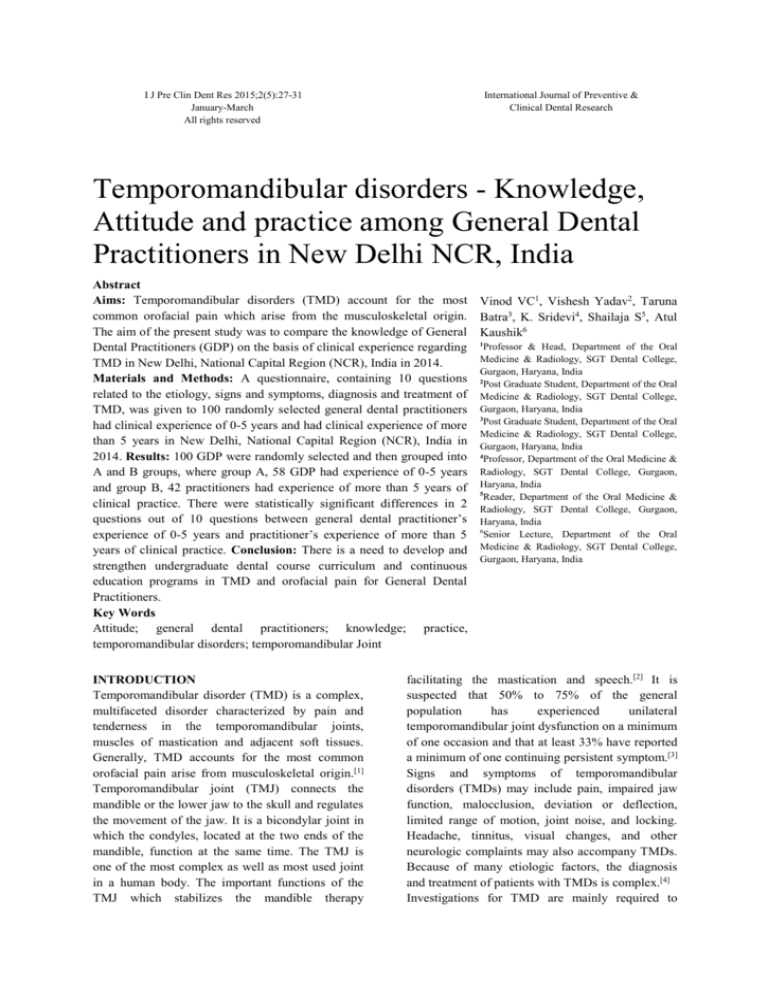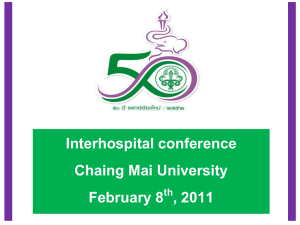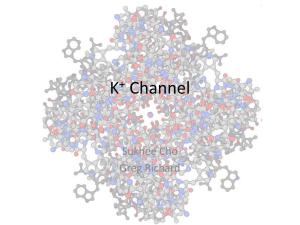
I J Pre Clin Dent Res 2015;2(5):27-31
January-March
All rights reserved
International Journal of Preventive &
Clinical Dental Research
Temporomandibular disorders - Knowledge,
Attitude and practice among General Dental
Practitioners in New Delhi NCR, India
Abstract
Aims: Temporomandibular disorders (TMD) account for the most
common orofacial pain which arise from the musculoskeletal origin.
The aim of the present study was to compare the knowledge of General
Dental Practitioners (GDP) on the basis of clinical experience regarding
TMD in New Delhi, National Capital Region (NCR), India in 2014.
Materials and Methods: A questionnaire, containing 10 questions
related to the etiology, signs and symptoms, diagnosis and treatment of
TMD, was given to 100 randomly selected general dental practitioners
had clinical experience of 0-5 years and had clinical experience of more
than 5 years in New Delhi, National Capital Region (NCR), India in
2014. Results: 100 GDP were randomly selected and then grouped into
A and B groups, where group A, 58 GDP had experience of 0-5 years
and group B, 42 practitioners had experience of more than 5 years of
clinical practice. There were statistically significant differences in 2
questions out of 10 questions between general dental practitioner’s
experience of 0-5 years and practitioner’s experience of more than 5
years of clinical practice. Conclusion: There is a need to develop and
strengthen undergraduate dental course curriculum and continuous
education programs in TMD and orofacial pain for General Dental
Practitioners.
Key Words
Attitude; general dental practitioners; knowledge; practice,
temporomandibular disorders; temporomandibular Joint
INTRODUCTION
Temporomandibular disorder (TMD) is a complex,
multifaceted disorder characterized by pain and
tenderness in the temporomandibular joints,
muscles of mastication and adjacent soft tissues.
Generally, TMD accounts for the most common
orofacial pain arise from musculoskeletal origin.[1]
Temporomandibular joint (TMJ) connects the
mandible or the lower jaw to the skull and regulates
the movement of the jaw. It is a bicondylar joint in
which the condyles, located at the two ends of the
mandible, function at the same time. The TMJ is
one of the most complex as well as most used joint
in a human body. The important functions of the
TMJ which stabilizes the mandible therapy
Vinod VC1, Vishesh Yadav2, Taruna
Batra3, K. Sridevi4, Shailaja S5, Atul
Kaushik6
1
Professor & Head, Department of the Oral
Medicine & Radiology, SGT Dental College,
Gurgaon, Haryana, India
2
Post Graduate Student, Department of the Oral
Medicine & Radiology, SGT Dental College,
Gurgaon, Haryana, India
3
Post Graduate Student, Department of the Oral
Medicine & Radiology, SGT Dental College,
Gurgaon, Haryana, India
4
Professor, Department of the Oral Medicine &
Radiology, SGT Dental College, Gurgaon,
Haryana, India
5
Reader, Department of the Oral Medicine &
Radiology, SGT Dental College, Gurgaon,
Haryana, India
6
Senior Lecture, Department of the Oral
Medicine & Radiology, SGT Dental College,
Gurgaon, Haryana, India
facilitating the mastication and speech.[2] It is
suspected that 50% to 75% of the general
population
has
experienced
unilateral
temporomandibular joint dysfunction on a minimum
of one occasion and that at least 33% have reported
a minimum of one continuing persistent symptom.[3]
Signs and symptoms of temporomandibular
disorders (TMDs) may include pain, impaired jaw
function, malocclusion, deviation or deflection,
limited range of motion, joint noise, and locking.
Headache, tinnitus, visual changes, and other
neurologic complaints may also accompany TMDs.
Because of many etiologic factors, the diagnosis
and treatment of patients with TMDs is complex.[4]
Investigations for TMD are mainly required to
28
Temporomandibular disorders
Subjects
Vinod VC, Yadav V, Batra T, Sridevi K, Shailaja S, Kaushik A
GDP
( 0-5
Years)
GDP
( >5
Years)
Chisquare
p-value
1.130
0.288
(NS)
Y
14
(24%)
N
44
(76%)
Y
16
(38%)
N
26
(62%)
2. Do you confidently diagnose TMD cases in your day
today practice?
26
(45%)
32
(55%)
24
(57%)
18
(43%)
0.739
0.390
(NS)
3. Do you feel clicking sound of TMJ is a abnormal sign?
38
(65%)
20
(35%)
24
57%)
18
(43%)
0.363
0.547
(NS)
4. Do you advice conventional (OPG) radiograph to the
TMD patients?
42
(72%)
16
(28%)
28
(67%)
14
33%)
0.192
0.662
(NS)
5. Do you prescribe any non pharmacological treatment
(Self care, Physiotherapy) for TMD patient?
48
(83%)
10
(17%)
40
(95%)
2
(5%)
1.796
0.180
(NS)
6. Do you prescribe any pharmacological treatment for
TMD patient?
34
(58%)
24
42%)
36
(86%)
6
14%)
4.258
0.039
(S)
26
(45%)
4
(7%)
12
(21%)
8
(14%)
32
(55%)
54
(93%)
46
(79%)
50
(86%)
34
(81%)
0
(0%)
4
(10%)
4
(10%)
8
(19%)
42
(100%)
38
(90%)
38
(90%)
1. Do you frequently get TMD patients in your practice?
7. Does the TMD patients reports back to you?
8. In case of reduce mouth opening do you directly advice
surgical treatment to the TMD patients?
9. Do you directly refer the TMD cases to the TMJ
specialist/ oral physician without any treatment?
10. Do you think an ENT doctor is the right person for
TMD problem?
Y= Yes, N= No, NS= Non – significant, S= Significant
eliminate the possibility of other abnormailties that
may mimic temporomandibular disorder symptoms
in addition to the definitive diagnosis. Despite the
limitations,
plain
radiographs
of
the
temporomandibular joint such as high level
orthopantomograms and transcranial projections are
the useful ways of visualising any gross
pathological, degenerative, or traumatic changes in
the bony component of the temporomandibular joint
complex. In recent years, magnetic resonance
imaging has been used increasingly to investigate
temporomandibular disorders, in particular, internal
derangements of the joint. Many other
investigations such as computed tomography and
arthroscopy have been also advocated for TMD.[5]
The diagnosis of orofacial pain can be quite difficult
and the diagnosis and treatment of this disorder is
still a challenge in the dental field. Across India and
most countries, dealing TMD as a part of the
training programme is mostly limited for
postgraduate students in schools of dentistry. As
majority of patients initially refer to General Dental
Practitioners (GDP), lack of proper knowledge,
awareness towards TMJ & TMD’s, not only leads to
misdiagnosis but also lead to wrong treatment or no
treatment therapy worsening the condition.
Therefore, awareness of dentist’s knowledge
6.623
1.509
1.130
0.210
0.010
(S)
0.219
(NS)
0.288
(NS)
0.647
(NS)
regarding the diagnosis and treatment of TMD is
very important.[6] In other countries, several studies
have evaluated the knowledge of general dental
practitioners in relation to the diagnosis and
treatment of TMD, but there are no sufficient
similar studies in India. The aim of the present
study was to compare the knowledge and attitudes
of general dental practitioners (GDP) on the basis of
clinical experience regarding TMD in National
Capital Region (NCR), India in 2014.
MATERIAL AND METHODS
This cross-sectional study was designed to include
General Dental Practitioners (GDP) practicing in
dental clinics in New Delhi National Capital Region
(NCR), India in which 100 GDP were selected
randomly. A questionnaire was designed to enquire
and assess whether the GDP come across the TMD
patients and their attitude regarding TMD and
management skills for the TMD. These GDP were
then divided into 2 groups based on their clinical
experience; Group A consisted of GDP with clinical
experience of 0-5 years and Group B consisted of
GDP with clinical experience of more than 5 years.
Data was collected using non standardized
customized questionnaires consisting of 10
questions about TMD and tabulated. The
questionnaire consisted of 10 questions with the
29
Temporomandibular disorders
option provided Yes and No. All the practitioners
were informed about the aim of the study and
assured of confidentiality of their answers. The
subjects were asked to complete the survey within
one week. In case of lost or incomplete
questionnaires, a reminder was sent up to 3 times,
and obtained completed questionnaires. After
collecting the completed questionnaires, data were
analyzed using SPSS 20. Descriptive statistics was
carried out in the present study and Chi square test
was used to compare proportions and p value <0.05
was considered to be significant.
RESULTS
100 GDP were randomly selected and then grouped
into A and B groups, where group A, 58 GDP had
experience of 0-5 years and group B, 42
practitioners had experience of more than 5 years of
clinical practice. There were statistically significant
differences in 2 questions out of 10 questions
between general dental practitioner’s experience of
0-5 years and practitioner’s experience of more than
5 years of clinical practice (Table I). The two
statistically significant questions were “Do you
prescribe any pharmacological treatment for TMD
patient” and “Does the TMD patients reports back
to you”. However, remaining 8 questions were
found to be statistically non significant.
DISCUSSION
TMD is a general term including clinical problems
which affect masticatory muscles, TMJ and adjacent
structures. TMD is the most common non-dental
pain affecting the maxillofacial region. The most
common sign of TMD is pain in masticatory
muscles, or preauricular region and on the TMJ
which becomes severe when chewing or upon other
mandibular movements. TMD patients have
limitation and asymmetry in mandibular
movements.[7] Pain may radiate to the head, face, or
eye. Sounds such as crunching, popping, or grinding
are usually described. A few patients may describe a
jaw that occasionally locks; the patient may have to
wiggle the jaw to unlock it.[8] Patients may complain
from headache, earache and pain in the
maxillofacial
region.
Masticatory
muscle
hypertrophy and an unusual facet of occlusal
surfaces of the dentition due to excessive
mandibular movements such as bruxism or grinding
may be present. Management of TMJ disorders
usually includes finding the cause or etiology.
Parafunction and trauma are common causes of
TMD, however Stress and mental problems are
secondary aggravating factors.[7] The results of the
Vinod VC, Yadav V, Batra T, Sridevi K, Shailaja S, Kaushik A
present study showed that the knowledge, attitude
and practice of general dental practitioners about
TMDs who had clinical experience of 0-5 years was
not similar to that of general dental practitioners
who had clinical experience of more than 5 years in
more than half of the questions. Most of the
disagreements rate between the two groups was in
management of TMDs. In the present study, less
experience general dental practitioners got less
TMD patients (24%) in clinical practice, whereas
more than 5 years of clinical experience
practitioners got more TMD patients (38%). It
indicates that patients prefer and trust more on more
clinically experienced practitioners for the
treatment. However, the results were found to be
statistically non-significant (p>0.5). According to
present study, 0-5 years experienced practitioners
diagnosed TMD patients (45%) less confidently in
clinical practice, whereas more than 5 years of
clinical experience practitioners diagnosed TMD
patients (57%) with more confidence. However, the
results were found to be statistically non significant
(p>0.5) for this comparison in two groups. 45%
TMD patients reported back to practitioners who
had experience of 0-5 years and 81% TMD patients
reported back to practitioners who had experience
of more than 5 years. Also, the results were found to
be statistically significant for this comparison in two
groups. It shows, the more experienced dental
practitioners has more command in handling these
TMD patients which reinforces the fact that a good
clinical experience plays a crucial role in the
treatment of a TMD cases. According to Baharvand
M et al.,[1] the majority of the younger dentists do
not have appropriate knowledge & acumen to
diagnose TMD since they do not emphasize much
on obtaining information and updating their
knowledge regarding it. In present study, 65%
practitioners who had less experience felt clicking
sound of TMJ was a abnormal sign whereas 57%
practitioners who had more than 5 years of clinical
experience felt clicking sound of TMJ was a
abnormal sign. However, the results were found to
be statistically non-significant (p>0.5) for this
comparison between the two groups. Tegelberg et
al.,[9] surveyed the experience and routine of
attitudes and need for specialist resources in the
treatment of TMD in children and adolescents
among general dentists. They sent a questionnaire to
286 Public Dental Service dentists. It contained
questions on demographic data, quality assurance,
clinical experience and expertise, attitudes, and the
30
Temporomandibular disorders
need for specialist resources. Eighty-seven percent
(250) of dentists filled in the questionnaire. Good
experience concerning diagnostics and therapy
decision was reported by 25 - 50% of the dentists;
55% of the dentists had positive attitude toward the
care of children and adolescents with TMD. A large
need for specialist resources with the possibility for
referrals or to consult was reported.[9] It appears that
the inability of general dental practitioners in
managing TMD patients was related to their
inadequate knowledge about this disorder. There is
consensus
regarding
the
inadequacy
of
undergraduate dental education in TMD and
orofacial pain, which emphasizes the need to
develop and strengthen the curriculum regarding the
problem.[9] According to present study, 72%
practitioners who had experience of 0-5 years
advice conventional (OPG) radiograph to the TMD
patients, whereas 67% practitioners who had more
than 5 years of clinical experience advice
conventional (OPG) radiograph to the TMD
patients. However, the results were found to be
statistically non-significant (p>0.5) in two group for
this comparison. These results could be because
practitioners who have more experience of clinical
practices, give more importance to the clinical
findings of the patients while giving diagnosis in
TMD patients. According to Baharvand M et al.[1]
Furthermore, lack of encounter with TMD patients
by dental students during their education has led to
lack of practice and knowledge regarding the
etiologic factors of TMDs. The same trend is
present even during their practice when confronting
a TMD case, where the dentist does not put enough
effort into looking for the underlying cause and
makes a hasty diagnosis on the sight of the first sign
and symptom, leading to a treatment that only
relieves the pain and discomfort in the least amount
of time possible.[1] For treatment, when asked from
the GDP, mostly the practitioners of both the groups
practitioners prescribed non pharmacological
treatment (i.e. self care, physiotherapy) to the
patient, but majority of the practitioners who had
experience of more than 5 years prescribed (95%)
and overtook the practitioners who had less
experience (83%). However, the results were found
to be statistically non significant for the comparison
between two groups. Another treatment modality,
when
asked
from
the
GDP
regarding
pharmacological treatment modality, majority of
practitioners who had more experience of clinical
practice prescribed more pharmacological treatment
Vinod VC, Yadav V, Batra T, Sridevi K, Shailaja S, Kaushik A
(86%) in comparison with practitioners who had
less experience of clinical practice (58%). Also, the
results were found to be statistically significant for
comparison of both the groups. Tegelberg et al.,[10]
in another study examined the knowledge of GDP
about Temporomandibular disorders in children and
adolescents. The overall response rate to the
questionnaire was 87%. They reported a high
degree of consensus in TMD knowledge among
TMD specialists and a high degree of agreement in
knowledge between GDP and TMD specialists. The
highest number of significant intergroup differences
was found in the treatment and prognosis. However,
these findings are contrary to the results of our
study where the GDP were grouped on the basis of
their clinical experience. This could also be
explained by the contributing facts that
undergraduate curriculum are different in different
countries.[10] In case of reduced mouth opening,
none of the practitioners (0%) who had experience
of more than 5 years of clinical practice directly
advice surgical treatment to the TMD patients in
comparison who had experience of less than 5 years
of clinical practice. When further asked from GDP,
90% practitioners who had experience of more than
5 years did not directly refer the TMD cases to the
TMJ specialist/oral physician without any treatment
in comparison with the practitioners who had less
experience of clinical practice. However, the results
were found to be statistically non significant for
both the comparison in two groups. According to
MH Steenks11 diagnosis and treatment of TMD are
usually limited to simple cases for general dental
practitioners. One of the therapeutic strategies in
acute orofacial pain is referral to a specialist.
Therefore, dental students have to learn the
thorough examination, diagnosis and management
of non-complex cases in dental schools. They must
also learn to refer complicated cases with initial
treatment prescribed to the TMDs patient.[11] In
response to the question whether ENT doctors were
the right person for TMD problem, majority did not
agree with the statement from both the groups.
Also, the results were found to be statistically non
significant.
CONCLUSION
The present study is first of its kind represented
among Indian GDP and an attempt is made towards
the knowledge, attitude and practice of TMDs.
Although more experienced GDP have an overall
advantage in diagnosing and treating the TMD
patients in comparison with less experienced
31
Temporomandibular disorders
practitioners in their clinical practice, more
emphasis should be given to TMDs as a part of
curriculum during training period. Furthermore our
results suggest a regular upgrade of knowledge
regarding TMD with the help of various
Conferences / CDE programs, training on
diagnosing and treating TMD patients and
workshops as the need of hour for the less
experienced general dental practitioners.
REFERENCES
1. Baharvand M, Monfared MS, Hamian M,
Moghaddam EJ, Hosseini FS, Alavi K.
Temporomandibular Disorders: Knowledge,
Attitude and Practice among Dentists in
Tehran, Iran. Journal of Dental Research,
Dental Clinics, Dental Prospects 2010;4(3):9094.
2. Ingawale S, Goswami T. Temporomandibular
Joint:
Disorders,
Treatments,
and
Biomechanics.
Annals
of
Biomedical
Engineering. 2009;37(5):976-96.
3. Reneker J, Paz J, Petrosino C, Cook C.
Diagnostic Accuracy of Clinical Tests and
Signs of Temporomandibular Joint Disorders:
A Systematic Review of the Literature. Journal
of orthopaedic & sports physical therapy
2011;41(6):408-16.
4. Herb
K,
Cho
S,
Stiles
MA.
Temporomandibular
joint
pain
and
dysfunction. Current Pain and Headache
Reports 2006;10:408-14.
5. Dimitroulis G. Temporomandibular disorders:
a clinical update. BMJ 1998;317:190-4.
6. Jamalpour MR, Biglarkhany M, Rabiei A,
Mirzaei Z. Knowledge and Beliefs of General
Dental
Practitioners
regarding
Temporomandibular Disorders in Sanandaj,
Iran. DJH 2011;3(2):27-33.
7. Navi F, Motamedi MHK, Talesh KT, Lasemi
E, Nematollahi Z. Diagnosis and Management
of Temporomandibular Disorders. A Textbook
of Advanced Oral and Maxillofacial Surgery.
p 831- 858.
8. Knight J. Diagnosis and Treatment of
Temporomandibular Disorders in Primary
Care. Hospital Physician. June 1999;55- 58.
9. Tegelberg A, List T, Wahlund K, Wenneberg
B. Temporomandibular disorders in children
and adolescents: a survey of dentists’ attitudes,
routine and experience. Swed Dent J
2001;25(3):119-27.
Vinod VC, Yadav V, Batra T, Sridevi K, Shailaja S, Kaushik A
10. Tegelberg A, Wenneberg B, List T. General
practice
dentist’s
knowledge
of
temporomandibular disorders in children and
adolescents. Eur J Dent Educ 2007;11(4);21621.
11. Steenks MH. The gap between dental
education
and
clinical
treatment
in
temporomandibular disorders and orofacial
pain. J Oral Rehabil 2007;34(7):475-7.





